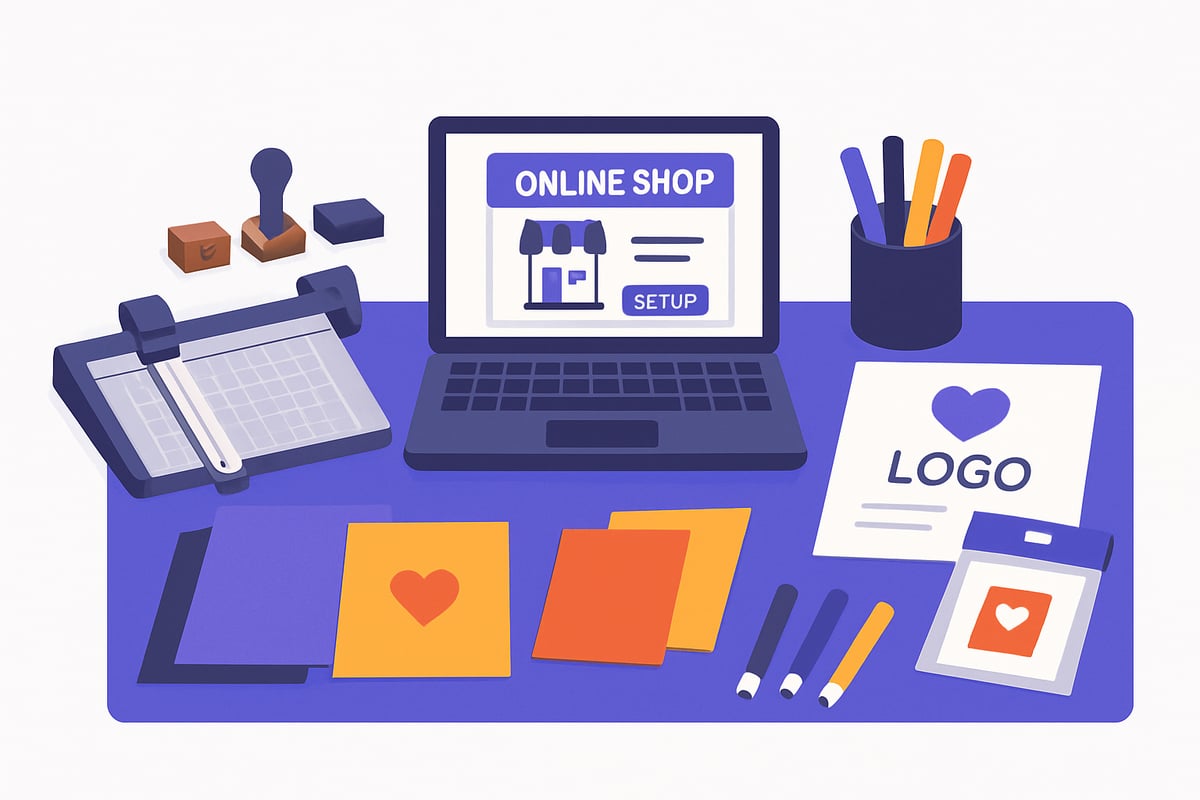Card Making Business Guide for Beginners (2025)
13 minutes
11th of October 2025
In this article:
- Understanding the Card Making Market in 2025
- Essential Skills, Tools, and Materials for Card Making
- Step-by-Step: Setting Up Your Card Making Business
- Developing and Showcasing Your Card Designs
- Marketing, Selling, and Growing Your Card Making Business
The card making business is booming in 2025, capturing the imagination of creative entrepreneurs and those seeking profitable home-based ventures. More consumers are choosing unique, personalized cards, making this an exciting time to turn your passion into a thriving business.
This guide is designed for beginners who want to launch a successful card making business from scratch. You will find practical steps for market research, developing essential skills, setting up your business, creating products, marketing, and scaling for growth.
Are you ready to unlock your creative and financial potential? Let’s dive into this comprehensive guide and start your journey toward a rewarding card making business.
Understanding the Card Making Market in 2025
Starting a card making business in 2025 means entering a vibrant, evolving market. Understanding current trends, your audience, competitors, and legal requirements will lay a strong foundation for your venture. Let us explore the market landscape step by step.

Market Trends and Opportunities
The card making business is experiencing significant growth, with the handmade greeting card sector expected to expand steadily through 2025. Consumers are increasingly drawn to cards that feel personal, meaningful, and eco-friendly. According to Greeting Card Market Trends 2025, personalized and sustainable designs are leading the market, reflecting a broader shift toward conscious consumerism.
Recent statistics from platforms like Etsy and Notonthehighstreet show a consistent rise in handmade card sales, especially during holidays, weddings, and birthdays. In fact, a 2024 survey revealed that 60 percent of buyers now prefer personalized cards over generic alternatives. This presents a golden opportunity for those starting a card making business focused on unique, custom designs.
Seasonal and event-driven demand also plays a crucial role. Makers who align their collections with key occasions tend to see higher sales spikes throughout the year. Staying in tune with these trends will help your card making business capture loyal customers and maximize profitability.
Identifying Your Target Audience
Defining your ideal customer is essential for any successful card making business. Start by considering factors such as age, interests, location, and the occasions they celebrate most. Are you designing for young couples planning weddings, eco-conscious families, or corporate clients seeking business greeting cards?
Niche opportunities abound within the card making business. For example:
- Eco-friendly cards for sustainability-minded buyers
- Luxury, hand-finished cards for premium markets
- Business thank-you cards for professional clients
Brands that specialize in a clear niche often build a devoted following. Studies show that niche targeting can boost a card making business's sales conversion rates by up to 30 percent. By focusing your efforts, you can stand out in a crowded market and offer products that truly resonate with your audience.
Competitor Analysis
Analyzing competitors is a critical step for any card making business. Begin by researching top sellers on Etsy, Instagram, and in local stores. Study their product offerings, price points, and customer feedback. Are there gaps in the market you can fill? Perhaps competitors offer only printed cards, leaving space for hand-painted or mixed-media designs.
Pricing analysis is equally important. Compare how similar products are positioned and what makes certain cards more appealing or valuable. This process helps you determine where your card making business can differentiate itself through quality, design, or custom services.
Here is a simple approach:
- List top competitors in your niche.
- Identify their strengths and weaknesses.
- Find opportunities to offer something unique, whether in style, materials, or presentation.
Legal and Ethical Considerations
Every card making business must address legal and ethical responsibilities from the start. Copyright law is crucial: avoid using images, quotes, or artwork you do not have rights to. Registering your business, obtaining insurance, and complying with local regulations are necessary steps to operate legally and protect your interests.
Ethical sourcing is also increasingly important in the card making business. Use materials that are environmentally friendly and ensure suppliers follow responsible practices. If you sell online, you must comply with GDPR and safeguard customer data.
A cautionary tale: One small business faced fines for using copyrighted images without permission. Such pitfalls can be avoided by understanding the legal landscape and prioritizing ethical choices. With these safeguards in place, your card making business will be built on a solid, trustworthy foundation.
Essential Skills, Tools, and Materials for Card Making
Launching a card making business in 2025 means mastering both creative skills and practical know-how. The right techniques, tools, and workspace setup lay the foundation for crafting cards that stand out and sell well. Whether you are starting as a hobbyist or aiming for a full-fledged card making business, building your expertise and managing your resources wisely is crucial.

Core Card Making Techniques for Beginners
To thrive in the card making business, beginners should focus on a handful of essential techniques. Stamping is a versatile method for adding crisp designs, while embossing creates texture and depth. Die-cutting lets you produce intricate shapes and layers. Hand lettering adds a personal, artistic touch, and collage techniques bring in mixed media flair.
Self-learning is easier than ever. YouTube tutorials, online workshops, and beginner-friendly courses can accelerate your progress. Investing time in mastering these basics ensures your card making business delivers quality products that attract loyal customers.
Popular beginner kits often include stamps, ink pads, embossing folders, and cutting dies. These kits help you practice skills before investing in advanced tools. Remember, every successful card making business starts with a strong foundation in technique.
Must-Have Tools and Materials
A well-equipped card making business relies on the right tools. Essential items include paper trimmers for precise cuts, scoring boards for crisp folds, and adhesives such as double-sided tape or glue dots. Cutting dies and stamps allow for creative customization, while quality markers and pens enhance your designs.
When choosing tools, weigh quality against your budget. High-end tools offer durability, but budget options can suffice for beginners. Supplies can be sourced from local craft stores or online wholesalers.
Here is a quick comparison of starter kit costs:
| Starter Kit Type | Typical Contents | Cost Range |
|---|---|---|
| Basic | Stamps, adhesives, trimmer, markers | $50–$80 |
| Intermediate | + embossing folders, cutting dies | $80–$150 |
| Advanced | + die-cutting machine, specialty tools | $150–$200 |
Balancing cost and quality helps your card making business remain sustainable as you grow.
Setting Up Your Creative Workspace
Creating a productive workspace is vital for any card making business. Start by organizing your supplies with clear storage bins and shelves. Keeping materials and finished cards separated helps maintain order and protects your work.
Good lighting reduces eye strain and ensures true color representation. A desk lamp with adjustable brightness is ideal. Ventilation is important, especially if you use adhesives or paints. Ergonomic seating and a clutter-free surface improve comfort and efficiency.
If space is limited, try vertical storage, collapsible tables, or wall-mounted organizers. These strategies help even small apartments accommodate a growing card making business.
Managing Costs and Budgeting
Smart budgeting is essential for a successful card making business. Typical startup expenses include tools, materials, packaging, and branding elements. Bulk buying supplies or upcycling materials can reduce costs significantly.
Track all expenses carefully using a simple spreadsheet or budgeting app. Set aside a portion of profits for reinvestment, allowing your card making business to upgrade tools or expand product lines over time.
For a detailed breakdown of expenses, the Startup Costs for Card Making Business page outlines what to expect when planning your budget. Most new businesses spend between $300 and $1,000 to get started, so plan accordingly and adjust as your card making business grows.
Step-by-Step: Setting Up Your Card Making Business
Starting a card making business in 2025 is an exciting journey that blends creativity with entrepreneurship. To help you succeed, this guide breaks down each essential step, from choosing your business structure to launching your first product line. By following these actionable steps, you can turn your passion for handmade cards into a thriving venture.

Choosing a Business Model and Structure
Selecting the right business model is foundational for your card making business. The main options are sole proprietorship, partnership, and limited liability company (LLC). Each structure offers distinct advantages and considerations.
| Structure | Pros | Cons |
|---|---|---|
| Sole Proprietorship | Simple setup, low cost, full control | Personal liability, harder to raise funds |
| Partnership | Shared responsibility, combined skills | Shared liability, potential disputes |
| LLC | Limited liability, credibility | Higher setup costs, more paperwork |
Most new card making business owners start as sole proprietors due to simplicity and minimal startup costs. However, if you plan to scale quickly or partner with others, an LLC may offer better protection.
Reflect on your long-term goals when choosing a structure. Consider consulting a small business advisor for tailored guidance.
Branding and Naming Your Business
A compelling brand sets your card making business apart. Start by brainstorming a unique, memorable name that reflects your creative style and values.
Branding essentials include:
- Logo design: Simple, versatile, and recognizable
- Color scheme: Choose 2-3 signature colors for consistency
- Brand voice: Decide if your tone is playful, elegant, or modern
Before finalizing your name, check for existing trademarks and domain availability. Invest in a professionally designed logo or use online tools to create one that aligns with your vision.
A cohesive brand builds trust and recognition, helping your card making business stand out in a crowded market.
Pricing Your Cards for Profit
Pricing is critical for the sustainability of your card making business. There are two main pricing strategies: cost-plus and value-based.
| Strategy | How it Works | When to Use |
|---|---|---|
| Cost-Plus | Add a markup to your total costs | For standard, low-volume cards |
| Value-Based | Price according to perceived customer value | For unique, premium designs |
To set your prices, factor in materials, time, packaging, and overhead. For example, handmade cards typically retail between $4 and $12 each. Offer product tiers to cater to different budgets.
Review competitor prices and adjust as needed. Transparent, fair pricing ensures your card making business is both competitive and profitable.
Setting Up Shop: Online and Offline
Launching your storefront is a pivotal step for any card making business. You can sell online, offline, or both.
Online Options:
- Etsy: Easy setup, large audience, listing fees
- Shopify/Own website: Full control, requires marketing
- Social media shops: Instagram, Facebook integration
Offline Options:
- Local craft fairs and markets
- Consignment in gift shops or boutiques
Setup Steps:
- Register accounts and set up payment methods.
- Create high-quality product photos and descriptions.
- Plan shipping and packaging logistics.
Each channel offers unique benefits. Many card making business owners start on Etsy for convenience, then expand to their own website for greater control.
Legal Setup and Business Registration
Proper legal setup is essential to protect your card making business and build credibility. Begin by registering your business according to your country or region's requirements.
Key legal steps:
- Choose and register your business name
- Obtain necessary licenses and permits
- Set up business banking and insurance
- Understand tax obligations and accounting basics
If you plan to sell online, ensure compliance with data protection laws like GDPR. Ethically source materials and be mindful of copyright when using images or quotes.
For a detailed overview of these requirements, consult resources like the Legal Requirements for Greeting Card Businesses.
Keep thorough records from day one. This not only helps with taxes but also supports the long-term growth of your card making business.
Creating Your First Product Line
Your first product line is the heart of your card making business. Start by designing a cohesive collection that reflects your brand identity and appeals to your target audience.
Tips for launching:
- Choose a theme (seasonal, occasion-based, or niche)
- Limit initial designs for focus and quality
- Use consistent packaging and branding
- Invest in professional product photography
Balance variety with a clear, recognizable style. A well-curated launch sets the tone for your card making business and attracts loyal customers from the start.
Developing and Showcasing Your Card Designs
Creating standout designs is essential for success in the card making business. From finding inspiration to presenting your products online, every step shapes your brand’s identity and customer appeal.

Finding Inspiration and Trends
Staying inspired is vital for any card making business. Look to Pinterest, Instagram, and design blogs for fresh ideas. Nature, art exhibits, and everyday life also spark creativity.
Keeping up with trends, such as Pantone’s Color of the Year or eco-friendly themes, can set your card making business apart. In 2025, personalized and irregular card shapes are on the rise. For a deeper dive into future opportunities, review the Irregular Card Market Forecast 2025-2033, which highlights emerging design possibilities and market shifts.
Track seasonal trends, like florals in spring or metallics during holidays, to keep your offerings timely. Save inspiring images to a digital mood board for easy reference.
Designing for Different Occasions and Audiences
A successful card making business offers designs for every milestone. Birthdays, weddings, holidays, and business events all require unique creative approaches. Consider your target audience’s preferences—some may love minimalist styles, while others want intricate, hand-painted details.
Customize cards for niches such as luxury buyers or eco-conscious customers. For instance, business thank-you cards often need a professional look, while wedding invitations can feature romantic calligraphy and floral motifs.
Balance variety and focus by developing themed collections. This helps your card making business appeal to different customer segments while maintaining a cohesive brand identity.
Photography and Presentation for Online Sales
High-quality photography is crucial for attracting buyers to your card making business. Use natural light or a daylight lamp, a neutral background, and simple props like ribbons or stationery. Arrange cards at various angles to showcase texture and detail.
Follow these tips for standout product photos:
- Use a tripod for sharp images.
- Shoot close-ups of unique features.
- Include scale references, such as a pen or hand.
Edit images to enhance brightness and color accuracy. Consistent photo style reinforces your card making business brand and builds buyer trust.
Writing Compelling Product Descriptions
Effective product descriptions are key to converting browsers into buyers in your card making business. Start with a captivating headline, then describe the card’s design, materials, and intended occasion.
Use storytelling to connect with customers. For example, explain the inspiration behind a design or share how it can be personalized. Highlight unique features, such as recycled paper or hand-lettered text.
A simple template for card making business listings:
Celebrate [occasion] with this handcrafted card, featuring [design details]. Made from [materials], perfect for [recipient or event]. Personalization available.
End with a call to action, inviting customers to order or request custom designs.
Marketing, Selling, and Growing Your Card Making Business
Building a successful card making business is about more than creativity. It requires strategic marketing, reliable sales channels, and a strong commitment to customer satisfaction. As you grow, focusing on brand development and smart scaling can set you apart in a competitive market.
Building Your Online Presence and Brand
A professional online presence is essential for any card making business. Start with a clean, user-friendly website that highlights your unique style and product range. Consistent branding across your website, blog, and social media profiles builds trust and makes you memorable.
Use your brand colors, logo, and voice everywhere your business appears. Email newsletters help you nurture customer relationships by sharing new products, stories, and exclusive offers.
- Create a content calendar to post regularly.
- Share behind-the-scenes photos and creative processes.
- Respond promptly to comments and messages.
An active, well-branded online presence positions your card making business as credible and customer-focused.
Leveraging Online Marketplaces and Craft Fairs
Selling on platforms like Etsy, Amazon Handmade, and Notonthehighstreet opens your card making business to a global audience. Optimize your listings with high-quality photos, clear descriptions, and relevant keywords. Research peak seasons and adjust your inventory for holidays and special events.
Local craft fairs and markets offer face-to-face interaction and immediate feedback. Stand out with eye-catching displays, organized packaging, and friendly service.
- Prepare a checklist for each selling platform.
- Track market fees and commission rates.
- Offer limited edition cards for events.
For more details on optimizing your marketplace presence, the Etsy Seller Handbook is a valuable resource.
Social Media and Content Marketing Strategies
Social media is a powerful tool for growing your card making business. Create engaging content such as tutorials, time-lapse videos, and customer stories to showcase your expertise. Platforms like Instagram, TikTok, and Pinterest are ideal for visual storytelling.
Use reels, stories, and live demos to connect with your audience in real time. Collaborate with influencers or fellow makers to expand your reach.
- Post consistently using a mix of content types.
- Use trending hashtags and participate in challenges.
- Feature customer testimonials and user-generated content.
A well-executed content strategy keeps your card making business top-of-mind for your target market.
Customer Service and Building Loyalty
Outstanding customer service is crucial for any card making business. Prompt communication, personalized thank-you notes, and thoughtful packaging elevate the customer experience. Address questions quickly and resolve issues with empathy.
Encourage customers to leave reviews and refer friends. Implement loyalty programs or offer discounts to repeat buyers.
- Send follow-up emails after purchases.
- Include care instructions or special messages in packages.
- Track customer feedback and respond to suggestions.
Positive reviews not only boost your reputation but can also improve your search rankings on platforms like Etsy.
Scaling Up: Wholesale, Collaborations, and Passive Income
As your card making business grows, explore opportunities beyond direct sales. Wholesale partnerships with retailers and boutiques can expand your reach. Collaborate with event planners, subscription boxes, or local businesses to diversify your offerings.
Consider passive income streams such as selling digital card templates, printables, or online courses. This can supplement your handmade product sales and build long-term revenue.
- Research retailers for potential wholesale accounts.
- Develop a pitch for collaborations.
- List digital products on sites like Creative Market.
Smart scaling strategies help your card making business thrive in an ever-evolving marketplace.
Now that you have a clear roadmap to launching your own card making business in 2025, it’s time to take your networking to the next level. Imagine being able to instantly share your contact details and portfolio with potential partners, customers, or fellow creators—no printing, apps, or design experience required. With Spreadly’s digital business cards, you can showcase your brand, capture leads, and keep your information up to date wherever you go. Ready to make a memorable first impression and grow your creative business with ease? Try for free and see how simple professional networking can be.






